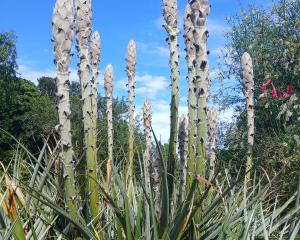
Waving a hand at his garden, Ralph Allen says: "Thirty-five years ago, this was a gorse-filled clearing in the bush."

In 1978, "with dynamite", as Ralph says, the drive was created, swooping down into a gully and up to where the house was built.
Then came the trees and lots of rhododendrons, starting with Sonata, in memory of Ralph’s father.
The air is scented with a Rhododendron loderi, possibly King George, and CIS frames the view across the harbour. Ralph points out Lem’s Cameo, which is one of his favourite rhododendrons, although he admits "you either love it or hate it".
His partner, Lidy Riedstra, prefers perfumed R. nuttallii, saying: "Its bark is so beautiful."
A joint favourite is Ilam Cream, one of a series with the Ilam prefix bred in Christchurch by Edgar Stead, and they also agree that bright red Cornubia did them proud this year, flowering for more than four months.
"It was incredible," Ralph says, blooms from mid-July until the end of October.
As time has passed and trees have grown, Lidy’s once-sunny spring border has become shadier so she has changed to plants that do better in the changed conditions, including hellebores, trilliums and the rarely seen wood rush (Luzula).
"You learn, in the end, to grow what you can grow," she says.

A cost-effective approach as been what she calls robbing from other areas and "cramming things in to beat the weeds".
Bugleweed (Ajuga reptans) is widely used as a groundcover — "it’s great here” — while the glossy leaves and dark blue flowers add colour that complements the shrubs and trees.
One of the first large projects was a pond with an islet on which a pink rhododendron grows happily.
In the pond are native freshwater crayfish (koura) that made their own way from the stream that feeds the pond. They tend to hug the bottom, unlike Maxim, Poseidon and Frisky, the couple’s trio of bright orange goldfish, whose homes are two large whaling pots.

A pest they don’t have is snails, so hostas grow well without unattractive holes. They have planted some in the gully, a relatively new part of the garden where gorse and Darwin’s barberry previously ruled.
Nearby is the grotto. When a slip pushed masses of rock towards a stream, repairs had to be made and a wall of gabion baskets was used to prevent further damage.

Leftover rock from the repair work went to another project, a folly so realistic than one visitor asked if it was a ruined chapel, exactly the look that was intended.
The starting point was a church-style window Ralph had crafted about 20 years earlier and left sitting in the bush. Then the brickwork was added until, after 10 months, the folly was completed, looking as the visitor noted, just like the ruins of a small church.
In short, in 35 years, the once unpromising site high above St Leonards has become a notable garden.











